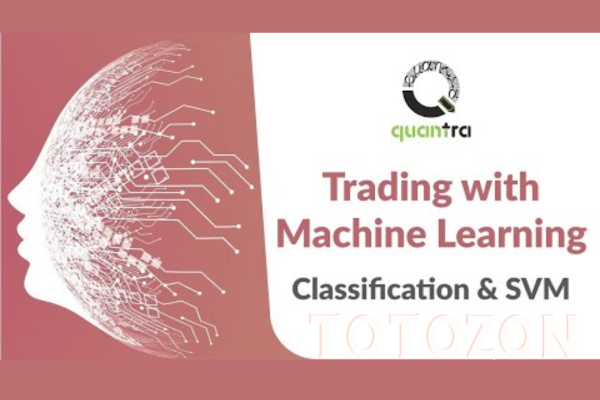Trading with Machine Learning Classification and SVM – QuantInsti
$72.00 Original price was: $72.00.$23.00Current price is: $23.00.
File Size: 152 MB
Delivery Time: 1–12 hours
Media Type: Online Course
Content Proof: Watch Here!
You may check content proof of “Trading with Machine Learning Classification and SVM – QuantInsti” below:
Trading with Machine Learning Classification and SVM – QuantInsti
Introduction
In the dynamic world of financial markets, machine learning techniques such as classification and Support Vector Machines (SVM) are revolutionizing how traders analyze data and make decisions. QuantInsti’s innovative approach integrates these sophisticated tools, enhancing traders’ capabilities to predict market movements with remarkable accuracy.
What is Machine Learning Classification?
Machine learning classification involves assigning data into predefined categories using algorithmic models. It is crucial in trading for identifying patterns that indicate buy or sell signals.
Understanding Support Vector Machines (SVM)
SVM is a powerful machine learning model used for classification and regression challenges. In trading, SVM helps in identifying clear margins of separation between different asset classes or expected price movements.
Foundations of SVM in Trading
Before applying SVM to trading strategies, one must understand its foundational principles and how it applies to market data.
Principles of SVM
Exploration of the basic principles behind SVM, including hyperplanes, kernels, and margin maximization.
SVM for Market Prediction
How SVM can be configured to analyze financial data and predict market trends effectively.
Data Preparation for SVM Trading Models
The accuracy of any machine learning model depends significantly on the quality of data used.
Data Collection
Guidelines on collecting the right type of financial data that can be effectively used for SVM models.
Feature Engineering
Techniques for transforming raw data into meaningful features that significantly impact the performance of SVM classifiers.
Building SVM Trading Models
Step-by-step guidance on developing SVM-based trading strategies.
Selecting the Right Kernel
Discussion on choosing the appropriate kernel function to enhance the model’s ability to handle complex market data.
Training the SVM Model
Best practices for training SVM models to ensure they learn from historical data without overfitting.
Integrating Machine Learning Classification
Beyond SVM, other classification methods can also be valuable in trading.
Logistic Regression
Exploring how logistic regression can complement SVM models by estimating probabilities of market movements.
Decision Trees
Utilization of decision trees to capture nonlinear relationships in market data that SVM might miss.
Backtesting SVM Models
Evaluating the effectiveness of SVM trading strategies through rigorous backtesting.
Backtesting Methodology
Outlining the methods for backtesting SVM models to validate their predictive power and robustness.
Interpreting Backtesting Results
How to analyze backtesting results to refine the trading strategy further.
Risk Management with SVM
Implementing risk management techniques to safeguard investments when using SVM trading models.
Setting Risk Parameters
Establishing risk management parameters that align with the volatility and risk profile of the trading model.
Dynamic Adjustments
Adaptive strategies for modifying SVM models in response to changing market conditions to manage risk effectively.
Advanced Techniques in SVM Trading
For those looking to deepen their use of SVM in trading, advanced techniques can provide additional edges.
Ensemble Methods
Combining multiple SVM models through ensemble methods to enhance predictive accuracy.
Deep Learning Integration
Incorporating elements of deep learning with SVM to tackle more complex or subtle patterns in financial markets.
Learning from QuantInsti
QuantInsti provides comprehensive resources and courses to master SVM and other machine learning techniques in trading.
Educational Courses
Details on QuantInsti’s courses that cover machine learning classification and SVM in-depth.
Webinars and Workshops
Upcoming webinars and workshops that focus on practical applications of SVM in trading.
Conclusion
Machine learning classification and SVM offer powerful tools for traders seeking to gain a competitive edge in the financial markets. Through QuantInsti’s expert training and resources, traders can effectively harness these advanced techniques to enhance their trading strategies and achieve better predictive accuracy.
FAQs
- What makes SVM suitable for trading?
- SVM’s ability to find the optimal boundary between different classes makes it exceptionally suitable for the classification problems often encountered in trading.
- How do I start with SVM in trading?
- Begin by understanding the basic concepts of SVM, followed by hands-on training through courses such as those offered by QuantInsti.
- What are the risks of using SVM in trading?
- While SVM is powerful, it can be sensitive to overfitting and might not perform well if the feature selection and parameter tuning are not handled correctly.
- Can SVM be used for all types of financial instruments?
- Yes, SVM can be applied across various instruments like stocks, forex, and derivatives, provided the model is trained with relevant data.
- How can I access QuantInsti’s resources on SVM and machine learning?
- Visit the QuantInsti website to explore their educational offerings, including detailed courses, webinars, and articles on SVM and other machine learning techniques.
Be the first to review “Trading with Machine Learning Classification and SVM – QuantInsti” Cancel reply
You must be logged in to post a review.
Related products
Forex Trading
Forex Trading
Forex Trading
Forex Trading
The Complete Guide to Multiple Time Frame Analysis & Reading Price Action with Aiman Almansoori
Forex Trading
Forex Trading
Forex Trading
Forex Trading
Forex Trading
Forex Trading
Quantamentals – The Next Great Forefront Of Trading and Investing with Trading Markets
Forex Trading
Forex Trading

 The Orderflows Trade Opportunities Encyclopedia with Michael Valtos
The Orderflows Trade Opportunities Encyclopedia with Michael Valtos  The Trading Blueprint with Brad Goh - The Trading Geek
The Trading Blueprint with Brad Goh - The Trading Geek 




















Reviews
There are no reviews yet.